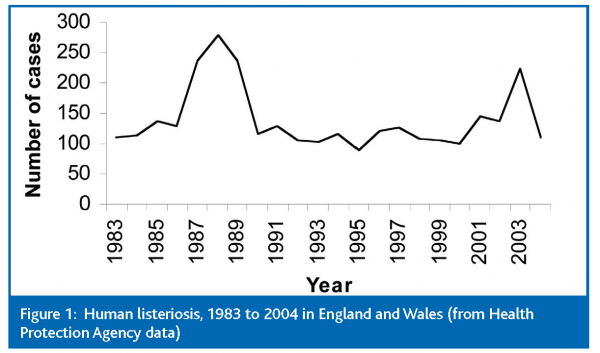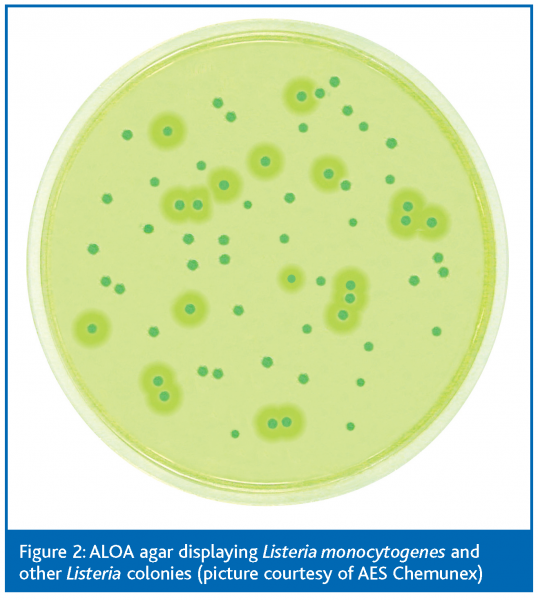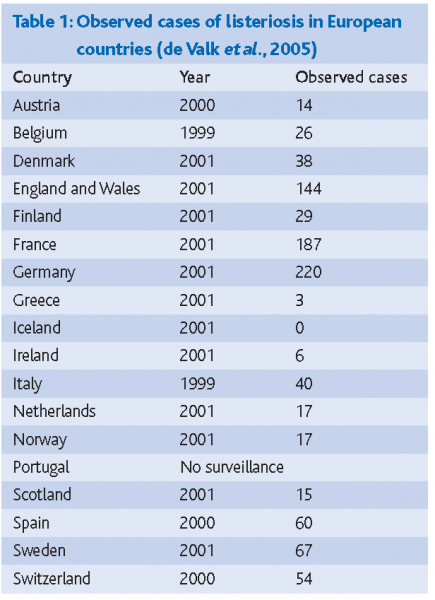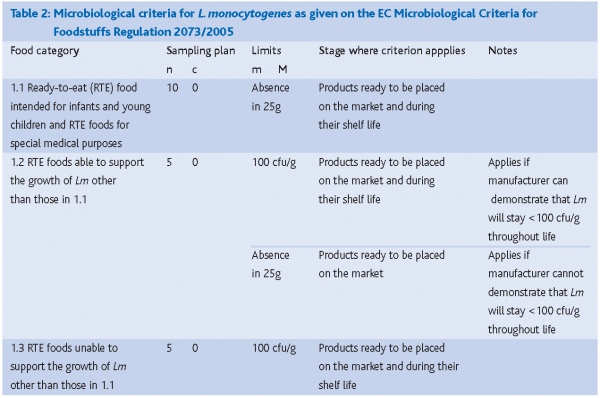Listeria monocytogenes – a recent history
- Like
- Digg
- Del
- Tumblr
- VKontakte
- Buffer
- Love This
- Odnoklassniki
- Meneame
- Blogger
- Amazon
- Yahoo Mail
- Gmail
- AOL
- Newsvine
- HackerNews
- Evernote
- MySpace
- Mail.ru
- Viadeo
- Line
- Comments
- Yummly
- SMS
- Viber
- Telegram
- Subscribe
- Skype
- Facebook Messenger
- Kakao
- LiveJournal
- Yammer
- Edgar
- Fintel
- Mix
- Instapaper
- Copy Link
Posted: 11 August 2006 | P A Voysey, Campden and Chorleywood Food Research Association | No comments yet
Listeria monocytogenes is a pathogenic bacterium and one of six species belonging to the genus Listeria. This species is the only one believed to be pathogenic to man; however, not all L. monocytogenes serotypes have been linked with illness. The bacterium is very common in the environment. It has been found in at least 37 mammalian species, as well as 17 species of birds and possibly some species of fish and shellfish. It can be isolated from soil, silage and other environmental sources. L. monocytogenes is quite hardy and resists the effects of freezing, drying and heat remarkably well for a bacterium that does not form spores.
Listeria monocytogenes is a pathogenic bacterium and one of six species belonging to the genus Listeria. This species is the only one believed to be pathogenic to man; however, not all L. monocytogenes serotypes have been linked with illness. The bacterium is very common in the environment. It has been found in at least 37 mammalian species, as well as 17 species of birds and possibly some species of fish and shellfish. It can be isolated from soil, silage and other environmental sources. L. monocytogenes is quite hardy and resists the effects of freezing, drying and heat remarkably well for a bacterium that does not form spores.
Listeria monocytogenes is a pathogenic bacterium and one of six species belonging to the genus Listeria. This species is the only one believed to be pathogenic to man; however, not all L. monocytogenes serotypes have been linked with illness. The bacterium is very common in the environment. It has been found in at least 37 mammalian species, as well as 17 species of birds and possibly some species of fish and shellfish. It can be isolated from soil, silage and other environmental sources. L. monocytogenes is quite hardy and resists the effects of freezing, drying and heat remarkably well for a bacterium that does not form spores.
L. monocytogenes causes a condition known as ‘listeriosis’ which manifests itself as septicemia, meningitis, encephalitis and intrauterine or cervical infections in pregnant women, which may result in spontaneous abortion or stillbirth.
The onset of these disorders is usually preceded by influenza-like symptoms including persistent fever. It was reported that gastrointestinal symptoms such as nausea, vomiting and diarrhoea may precede more serious forms of listeriosis or may be the only symptoms expressed. Gastrointestinal symptoms have been epidemiologically associated with use of antacids. The onset time to serious forms of listeriosis is unknown but may range from a few days to three weeks. The onset time to gastrointestinal symptoms is unknown but is probably greater than 12 hours. It has been reported (Hospital Episode Statistics, Department of Health, England, 2002-3) that the average (mean) length of stay in hospitals for persons with listeriosis in England 2002-3 was 28 days. So the disease needs to be treated with some seriousness, as the mortality rate can be as high as 30 per cent.
The infective dose of L. monocytogenes is thought to be more than 100 cfu/g (Table 2), but is believed to vary with the strain and susceptibility of the victim.
Listeria monocytogenes in England and Wales
In England and Wales, L. monocytogenes came to prominence in the 1980s as a food poisoning organism. It caused illness associated with imported pate and soft cheese made from unpasteurised milk. The bacterium became infamous because it caused still-births and deaths in the very young.
Following an explosion in the number of cases, which reached a peak in 1988, the government acted and advised pregnant women not to consume foods which were ‘risky’ with respect to listeriosis. This action led to a decline in cases.
A profile of the number of listeriosis cases in England and Wales is given in Figure 1. It can be seen that not only was there a peak of cases in the 1980s, but more recently there has also been an increase in the number of cases.
During the first ten months of 2003, the Health Protection Agency reported a general increase in cases of listeriosis in England. It was determined that these were associated with sandwiches, but also butter consumption (ACMSF, 2003). In those associated with butter, increases were seen in the Yorkshire, Humberside and the Northeast regions as compared to elsewhere in the UK (Anon, 2003). The reason for this increase was an outbreak of listeriosis (17 cases) linked to butter from a dairy in the general locality of these areas. This outbreak followed 25 cases of listeriosis in Finland in 1988-9 (Lyytiksinen et al., 2000), where again butter was found to be the incriminated food.
The Food Standards Agency in the UK is currently funding work which is managed by Campden and Chorleywood Food Research Association to look into the reasons why butter might carry a higher risk with respect to listeriosis than has traditionally been considered.
Interestingly, in England and Wales over the period 1993 to 2004, the proportion of listeriosis cases has shifted from being pregnancy-associated, to being associated with the elderly. From 2000 to 2004, 76 per cent of all listeriosis cases in England and Wales were associated with patients aged 60 years and over (Gillespie et al., 2005).
Listeria monocytogenes in Europe
Listeriosis is considered a serious disease across Europe. In 2002, a survey was carried out to assess the need for and the feasibility of a European network on Listeria infections in humans (de Valk et al., 2005). A total of 19 countries participated and only one (Portugal) had no surveillance system for listeriosis. In fact 12 had more than one system. Table 1 gives an overview of observed numbers of listeriosis cases in these countries.
It should be remembered when looking at this data that the size of population and approaches of different countries to collect this information will vary. Consequently the figures do not necessarily reflect the prevalence of listeriosis.
The new EU Micro Criteria Regulation
The European Union has been proactive in trying to reduce the number of cases of listeriosis across Europe. The EC Scientific Committee on Veterinary Measures and the Scientific Committee of Food recommended that the fraction of foods with a concentration of L. monocytogenes above 100cfu/g at the point of consumption should be reduced significantly (SCVMRPH, 1999). They also recommended that food manufacturers’ efforts should be focused on the food commodity types where L. monocytogenes can multiply, in order to ensure that products are in compliance with this recommendation.
As a consequence of this initial work, the EC has now published its Microbiological Criteria for Foodstuffs Regulation (2073/2005), which came into force on January 1st 2006. This document covers acceptable levels of a range of pathogens including L. monocytogenes, and other microorganisms in foods. The Regulation indicates that ready-to-eat foods containing up to 100 cfu/g of L. monocytogenes at point of consumption pose an acceptably low risk. Table 2 summarises the L. monocytogenes criteria.
A new medium for Listeria monocytogenes
The EU Microbiological Criteria require the use of the European and International Standards Listeria methods for food examination. These methods are described in EN ISO 11290 Parts 1 and 2: 1998, and were amended in 2004. The amendment concerned the agars that could be used to test for and grow Listeria monocytogenes. Prior to 2004 the media of choice were Oxford Agar and Palcam Agar. After the amendment, either Oxford or Palcam Agar could be used, but in addition to a medium called ALOA (Agar Listeria Ottavani & Agosti) Agar. This is a chromogenic agar where L. monocytogenes colonies show up as a blue-green colour and have a halo, while other Listeria species are blue-green in colour but without the halo (Figure 2).
Conclusions
Listeria monocytogenes continues to be an important pathogenic bacterium in the UK and in other parts of the world. Recent developments have suggested that levels of <100cfu/g pose a low risk, but this is disputed by some experts in the epidemiology of L. monocytogenes. Only time will tell what impact the EU Micro Criteria Regulation has on numbers of listeriosis cases.








References
Advisory Committee on the Microbiological Safety of Foods (ACMSF) (2003). Information paper. Recent Trends in Listeriosis in the UK. ACM/667. December, London, U.K.
Anon. (2003) Rise in listeriosis January to May, 2003 in the Yorkshire and Humberside Region. CDR Weekly 30 May; 13 (22), 2.
de Valk, H, Jacquet, C, Goulet, V, Vaillant, V, Perra, A, Simon, F, Desenclos, JC, Martin, P (2005) Surveillance of Listeria infections in Europe. Eurosurveillance, 10, 10-12, Oct-Dec.
Gillespie, I, McLauchlin, J, Adak, B, Grant, K, Little, C, Mithani, V, Penman, C & Sagoo, S (2005) Changing pattern of human listeriosis in England and Wales, 1993-2004. Report for the ACMSF. September.
Lyytiksinen, O, Autio, T, Maijala, R, Ruutu, P, Honkanen-Buzalski, T, Miettinen, M, Hatakka, M, Mikkola, J, Anttila, VJ, Johansson, T, Rantala, L, Aalto, T, Korkeala, H, Siitonen, A. (2000) An outbreak of Listeria monocytogenes serotype 3a infections from butter in Finland. Journal of Infectious Disease, 181: 1838-1841.
SCVMRPH (1999) Opinion of the Scientific Committee on Veterinary Measures Relating to Public Health on Listeria monocytogenes. 23 September.









